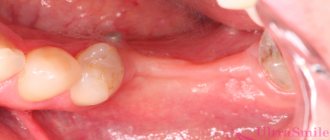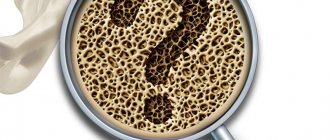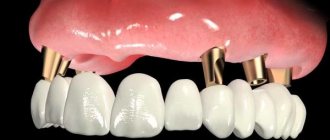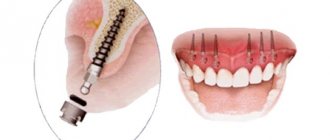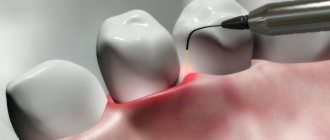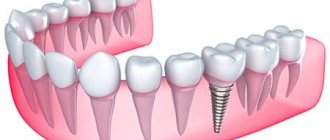Today, dental implantation is preferred by more and more patients in dental clinics, understanding the importance of reliability and quality of restoration of the integrity of the dentition.
This technique for correcting smile defects allows you to protect a person from dental health problems for many years.
However, due to the insufficient amount of bone tissue required for optimal implantation of the artificial root, most patients refuse implantation.
After all, it is much cheaper and easier to resort to other methods of prosthetics, which do not require complex procedures for increasing bone mass and enable the patient to become the owner of new teeth in a short time.
Implantology does not stand still and is ready to offer patients new methods of implanting titanium rods that do not require bone grafting. In this article we will look in detail at the so-called implantation without complications.
The essence of the technique
More than 6 years ago, residents of our country became acquainted with “explosive” publications about the emergence of the opportunity to restore teeth in one day.
“The hopeless are not hopeless!” - the headlines were full of stories. It is worth saying that the information not only aroused interest, but also gave hope to many patients who want to restore their teeth using an innovative technique.
A person is attracted not by an intriguing headline, but by modern dental services that allow him to achieve the desired result even in a hopeless situation. Bone tissue atrophy, which prevents high-quality dental implantation, has ceased to be a problem.
Most clinics in the Russian Federation began to use foreign implantation techniques. Here we can highlight the Frankfurt Protocol in the complete absence of elements of the dentition and the use of special titanium rods, implanted even if the volume of the jaw bone is insufficient.
When a specialist is dealing with a patient’s narrow bone, a splitting technique can be used, which does not require prior bone augmentation.
Splitting the bone ridge is a gentle surgical intervention in which the artificial root independently moves apart the bone structures during the implantation stages.
In comparison with classical implantation technology, when sinus lifting and bone grafting are necessary, and the final prosthetic restoration of dental units is completed after 12 months, splitting a narrow gingival ridge makes it possible not to resort to the procedure of transplanting dense bone tissue and restoring the integrity of the mucosa.
Thus, the number of operations is reduced to one, and the patient can receive a finished prosthesis in 3 months.
The first signs of dental implant rejection and ways to eliminate the problem. Let us consider here a reminder to the patient after dental implantation.
At this address https://dentist-pro.ru/implantaciya/metodiki/klassicheskaya/kogda-neobxodima-ustanovka-formirovatelya-desny.html watch a video of the process of installing the gum former.
What is bone grafting
Bone grafting is a bone augmentation surgery performed on both the lower and upper jaws. In the second case, it is called a sinus lift. During this manipulation, the surgeon builds up the bone to the required volume to allow implantation. Now there are many methods by which implants are installed even in patients with obvious bone atrophy (loss) without bone grafting. This does solve the problem of edentia, but only for a short time. We look to the future: patients do not come to us for teeth that will last them several years. But the main problems with implants do not begin immediately after their installation.
Indications and contraindications
Alveolar ridge splitting is recommended when bone atrophy is caused by the following reasons:
- periodontal anomalies;
- congenital features;
- absence of dental units and, accordingly, chewing load for a long time.
From a planning point of view, this mini-operation can be called low-traumatic and easy to perform.
However, experts note some limitations. The procedure can be used if the bone tissue biotype is optimal; moreover, the configuration of the alveolar ridge is also important .
The operation can be performed if:
- the width of the bone crest is at least 2 mm;
- height not less than 10 mm;
- the density of bone structures can be assessed as average.
Contraindications related to the patient’s health in general include:
- infections;
- inflammatory processes;
- allergic reactions;
- bleeding disorders.
The jaw bone is oval in shape. If the process of atrophy is started, its volume decreases on the side of the cheeks, while the base of the solid structure maintains its shape and becomes a support for the atrophied areas.
With such a clinical picture, a specialist can safely carry out splitting without worrying about the risks of bone damage. But, if the ridge is significantly thinned along its entire length, bone grafting cannot be done without. It is worth noting that such situations are rare in dental practice.
All-on-6 implantation and prosthetics on 6 implants
All-on-6 implantation is a special case of the All-on-4 technique, but it uses not four, but six implants. Additional 2 implants are placed in an inclined position in the lateral part of the jaw, and are embedded deeper than the others. The procedure for installing 6 implants begins with the installation of four implants in the front part of the jaw and ends with the installation of two implants in the posterior areas. This distribution has its advantages and is quite useful in some clinical situations.
Indications for All-on-6 implantation:
- Insufficient bone density (as a rule, this problem is typical for the upper jaw, where the bone is more porous and thin). “All on 6” implantation is optimal in order to prevent micromobility of implants and provide them with good primary stability.
- Risk of overloading 4 implants in some patients (for example, due to dietary habits and other factors);
- A wide jaw arch, where 4 supports may not be enough to firmly fix the prosthesis. In this case, the All-on-6 protocol also turns out to be an excellent way out of the situation.
The main advantage of implantation with 6 implants is the high reliability of the design. Even if for some reason one implant has to be removed, the stability of the prosthesis does not suffer, because the load is distributed evenly throughout the entire arc. Dentists recommend choosing the All-on-6 technology if the bone tissue has not had time to atrophy significantly and its thickness allows the installation of 6 implants.
Advantages and disadvantages
The procedure, aimed at splitting the alveolar ridge, allows you to quickly and effectively eliminate the problem.
The surgical intervention is aimed at opening the ridge and increasing its volume by installing an implant.
The advantages of the method are as follows:
- biomaterials and donor sites are not required;
- conditions for bone tissue regeneration are created instantly;
- gaining the opportunity to replenish horizontal and vertical loss of bone tissue;
- no risk of injury to the maxillary sinus;
- fast final prosthetics;
- short implant healing period;
- minimizing the risk of bleeding and inflammatory processes in tissues due to infections;
- significant savings in money.
Whatever one may say, there are no pros without cons. Therefore, the technique, which has so many advantages, also has minor disadvantages:
- not all clinical cases of bone deficiency can be resolved by splitting;
- the specialist must have sufficient manual to carry out the procedure, that is, understand the essence of the process, and such a doctor cannot be found in every clinic.
The method allows you to restore an unlimited number of dental units. Even in the case when the patient wants to implant one element of the dentition, the process of implanting a titanium rod is carried out in such a way as not to affect neighboring organs.
However, judging by statistics, the bone narrows with a high degree of edentia, so doctors resort to installing two or four implants on each side.
The structure of the bone tissue of our jaws
Let's figure out what bone tissue actually is. So, it consists of several layers: the soft spongy section, the cortical plate and the basal section, which is located at the base of the jaw bone. The spongy area after the loss of teeth or in the case of inflammation in the mouth is the first to undergo shrinkage or atrophy, because stops receiving adequate nutrition. In fact, it no longer works.
The photo shows the structure of the jaw bone tissue
But the cortical and basal areas are practically not susceptible to negative changes; they are very dense, which excludes the development of atrophic and inflammatory processes in them. That is why they are an excellent basis for attaching certain models of implants - they use both the central cancellous layer of bone, and the shell, and its lower or base layer (basal). This provides the artificial root with an incredibly strong position, stability, and primary stability.
It is due to these factors that bone grafting can be abandoned in the first place. But let’s make a reservation right away – you cannot use absolutely any implant for this. And also, for example, it is impossible to replace only 1-2 teeth using this principle. For all this there must be certain conditions. They will be discussed further.
Applied systems
Qualified and experienced specialists do not use all types of titanium rods for implantation without bone grafting. Special models with certain characteristics are suitable for these purposes.
As a rule, when the alveolar ridge is split, screw implants with a special configuration are used. Their body is made in a cone shape, which allows them to easily enter bone structures, slowly pushing them apart .
For maximum stability, the product is supplemented with a cylindrical thread profile. Such unique design features allow specialists to implant an artificial root even when working with a narrow bone, without resorting to increasing its volume.
The implant is screwed into a small hole (no more than 2 mm) without damaging the bone walls. The threads on such models are wide, so bone tissue grows through them quite quickly, which ensures reliable stabilization .
Additional characteristics that implants inserted into a narrow bone must have:
- special surface (hydrophilic);
- active type thread;
- possibility of implementation at an angle;
- antibacterial spraying;
- A one-piece type of construction is desirable.
What are basal implants and the cost of their installation. In this article you will find objective reviews about removable dentures with mini-implants.
Follow the link https://dentist-pro.ru/implantaciya/metodiki/klassicheskaya/zubov-iz-kakix-etapov-sostoit-eta-procedura.html if you are interested in dental implantation and the stages of system installation.
Myth No. 8: After implantation, you should not drink alcohol or smoke.
In the photo: installed implants immediately after careful tooth extraction
The success of implantation begins with gentle tooth extraction, allowing maximum preservation of the jaw bone without damaging it. It is very important to preserve the walls of the socket, since they are a natural framework for filling the socket with artificial bone granules, which promotes better regeneration of the jaw bone tissue in the socket area or around the implant, if the implantation was carried out in the socket of an extracted tooth.
Therefore, the main condition for simultaneous tooth implantation immediately after extraction is careful preparation and advance planning.
DETAILS: Dental treatment in France - how profitable is it?
It is worth recalling that under the condition of one-stage implantation, in the case when it is necessary to remove a tooth and replace it with an implant, it is very important to understand: tooth extraction and implant installation occurs in one step, after CAREFUL tooth removal, a dental implant is inserted, after which the crown is already fixed on the tooth .
If time passes after tooth extraction, even 1 day, then installation of the implant is postponed for 2 months until the tooth socket heals and the tissue is restored.
1. Classic or two-stage dental implantation, which is carried out as follows: first, the implant is installed, after which the gum is sutured, and after 2-4 months a permanent crown made of metal ceramics or zirconium dioxide is installed on the implant.
2. Dental implantation with immediate load or one-stage dental implantation: immediately after the implantation operation, a temporary crown is made on the tooth, and the implant heals under load for several months, after which the temporary crown is replaced with a permanent one.
This statement is completely false. The fact is that there are no universal tools. It's the same with implantation.
In the photo: a special implant for emergency dental implantation
For different dental implantation methods, implants of different structures are used, and what is good for classical implantation is not suitable for one-stage implantation.
For one-stage implantation, dental implants of a special structure are used, which allows them to withstand the chewing load immediately after implantation.
Therefore, if you are planning implantation, ask how many implantation systems the dental clinic has. A self-respecting dental clinic that deals with implantation professionally, and not from time to time, has several implantation systems in its arsenal. Make an appointment for a consultation
Modern dentistry is constantly evolving, and if previously dental implants were literally hammered into the patient’s jaw with a hammer, in a modern dental clinic everything is aimed at minimizing bone trauma and maximizing patient comfort.
During the implantation process, our clinic uses special equipment, and the installation of dental implants is carried out according to modern surgical protocols, which allows us to reduce tooth trauma to zero.
All this allows you to preserve the jaw bone and perform dental implant surgery with minimal trauma. In some cases, it is possible to carry out implantation through the gum or into the socket without bloodshed.
Most often, when hearing the word “implantation,” patients have a direct association with organ transplantation, and they naturally project this onto dental implantation. In fact, there is a huge difference between the engraftment of a donor organ and a dental organ.
A dental implant, unlike a transplanted organ, is integrated into the bone tissue (osseointegration) rather than engrafted.
Thus, the implant is securely held in the jaw bone. The healing process can be affected by infection of the tissues surrounding the dental implant, excessive stress on the implant, failure of the surgeon to follow the implant installation protocol, and the use of inappropriate equipment and instruments.
The information that implantation is impossible during pregnancy is absolutely true.
The fact is that the dental implant itself is not harmful and does not affect the body in any way, however, when installing dental implants, very strong anesthetics are used, which contain prolongators (most often adrenaline), the use of which is undesirable during pregnancy, and in some cases it is contraindicated.
Moreover, when implanting teeth, there is a need for x-rays, which is also undesirable.
Pregnancy for dental implantation is a temporary contraindication. So, implantation is possible after breastfeeding is completed.
Absolutely right. For several days after implantation, patients are strictly advised not to drink alcohol and also refrain from smoking.
Believe me, this is not because implantologists are so evil and forbid you to enjoy life, but because alcohol has an irritating effect on unhealed gums and makes healing difficult, and can also cause inflammation and implant rejection.
So, if you want to “disinfect” your wound after implantation, then think about the consequences and material cost of such an act.
Our patients often ask the question: do they need to take time off from work or take sick leave after dental implantation and whether the proposed implantation will affect the patient’s appearance.
Dental implantation is a low-traumatic process, naturally provided that the indications and implant installation protocols are followed. After surgery, patients often experience a slight feeling of heaviness in the implanted area for several days after surgery.
Most often, swelling is possible during more complex and extensive surgical interventions, such as bone grafting.
In our clinic, we use only high-quality and proven materials and try to make dental implantation as comfortable and low-traumatic for patients as possible. This allows our patients to feel comfortable both during and after dental implantation.
The doctors of our clinic are not limited by time - we are not in a hurry, and implantation takes exactly as much time as necessary. During implantation, the patient is not limited to one dose of anesthetic and, if you are worried, you can safely ask for “supplements”.
So, there are a number of myths around implantation, which are most likely born due to lack of knowledge or insufficient understanding of the entire process of dental implantation.
Believe me, now dental implantation is not an operation beyond the realm of possibility, but at the same time it requires certain knowledge, practice and proven materials and colossal work of dental implantologists.
Preparing for surgery
The success of the operation largely depends not only on the experience and skills of the specialist, but also on competent planning of the procedure during the preparation stages.
Before drawing up a plan for all manipulations aimed at restoring the integrity of the dentition, the doctor must assess the health of the patient’s body and oral cavity.
A general medical history is compiled based on the following measures taken:
- Examination of the body . The therapist must assess the patient's health. The conclusion is issued by a doctor based on the results of urine and blood tests. When diseases that can be quickly eliminated with medications are identified, the optimal course of treatment is prescribed. The patient is allowed to undergo surgery after complete recovery.
- Study of the features of the dental system . The specialist prescribes computed tomography and radiography. The data obtained will make it possible to determine the condition of the teeth, anatomical features and the degree of atrophy of the jaw bone.
- Sanitation of the oral cavity. At this stage, the doctor eliminates carious cavities and fills the canals.
We also carry out the removal of hard dental deposits, treatment of gum pockets, and treatment of periodontal tissues. If there are worn dentures in the patient's mouth, they must be replaced before surgery, taking into account the future compatibility of the materials. Restoration ends with professional cleaning. - Identification of contraindications. Determining indications and limitations is a mandatory procedure at the stages of preparation for surgery.
- Patient instruction . The doctor is required to advise the patient on preparation for surgery, hygiene rules and care of the installed structure.
Remarkable! In most dental clinics, implantologists refuse to perform surgery on patients who do not take care of their health, are burdened with bad habits, engage in hard work in everyday life, and neglect the rules of hygienic care. In such situations, patients are recommended to have removable prosthetics.
The success of the entire treatment also depends on the correct preparation of the patient himself. The memo includes the following medical recommendations:
- Examination and preparation must take place in the clinic that will perform the operation.
- The therapist's permission to perform surgery is required.
- It is better to avoid vaccinations before implantation, as they can cause a malfunction in the body’s immune system.
- The entire body is prepared 10 days before the titanium rod is inserted into the jaw bone. To do this, the patient must get a good night's sleep, give up alcoholic beverages and smoking, replenish the diet with vegetables, fruits and dairy products, and avoid physical fatigue.
- 7 days before your appointment with the surgeon, do not take blood thinners.
- The day before implantation, rinse your mouth thoroughly with antiseptic solutions.
- If the operation is scheduled for the morning, it is better to refuse a full breakfast and limit yourself to a glass of warm herbal decoction.
Alternatives to implantation for bone atrophy
Removable prosthetics
Installation of removable dentures when bone loss is possible, but the products do not provide an even load on the bone structure - its atrophy is inevitable.
The structures gradually deform and must be replaced regularly. More about the method
Bridges
The products rest on natural teeth - the load falls on only part of the row - the bone will dissolve. In addition, the supporting elements have to be ground.
More about the method
All specialists Our specialists
0:45
Omerelli Emir Romanovich
maxillofacial surgeon-implantologist and candidate of medical sciences
0:45
Voznyuk Vladimir Alexandrovich
maxillofacial surgeon-implantologist of the highest category
Features of the event
The operation for longitudinal splitting of the alveolar ridge with simultaneous one-step installation of a titanium rod is carried out according to the following scheme:
- Introducing anesthesia to the patient.
- Dissection of the mucosa no more than 2 mm outward from the planned site of splitting.
- Making a small incision in the bone using a special instrument whose action is based on microvibrations. The cut is made longitudinally, with a maximum depth of 5 mm.
- Plates that act as a mechanical expander are inserted into the cut, followed by their separation by 3 mm (the procedure is not always required).
- Installation of a special screw rod, which, thanks to its unique parameters, independently splits the bone ridge so that the total volume of solid structures increases.
- Suturing flaps along the wound line.
When specialists use plastic surgery using bone blocks, there is a need to carry out several operations aimed at collecting biological material, transplanting it, introducing an implant into the expanded jawbone and restoring the integrity of the gum tissue.
Important! In case of clefting, there is a need for a complex algorithm for restoring the integrity of the dentition. disappears
The video shows the sequence of implantation using the alveolar ridge splitting method.
Engraftment period
An artificial root made of titanium takes an average of 60 days to take root on the movable jaw, and about 90 days on the upper jaw. The time it takes to achieve favorable biological compatibility of the rod with tissues directly depends on the quality of primary stabilization and the density of bone structures.
If the bone is hard, the implant immediately after installation is able to resist displacement in all directions. With this outcome of implementation, the artificial root can be loaded with a crown after 60 days.
In the case of splitting of the alveolar ridge during implantation, the rod is in excellent contact with the bone even with its soft structure and is tightly fixed in it.
This stabilization was achieved thanks to the unique design of the thread, the wide steps of which help to increase the area of contact of the titanium product with hard tissues. Thus, we can conclude that the period of engraftment of the rod during implantation without complications is no more than 3 months.
Cost of the procedure
The price of the procedure consists of the cost of the implant, the doctor’s work, as well as the cost of temporary and permanent prosthetics. Due to the fact that specialists do not perform bone grafting, the price of implantation, of course, decreases, but not much. This technique was created not to save on implant installation, but to avoid additional surgery in cases where this is possible.
For example, if the bone volume is sufficient and its condition is ideal, you can install any modern implant - it will take root and function for a long time. But if it is necessary to carry out a sinus lift simultaneously with implantation, it will be necessary to use implants that are fixed even in 1 - 2 millimeters of bone.
But if the bone is narrow, the best option would be to use the splitting technique followed by installation of an implant with a wide thread. Everything is fair here - the doctor does not focus on your wallet, but advises and selects the most optimal treatment plan in accordance with the specific clinical situation.
Screw implants have a lifetime warranty because they are free from any defects: they will not crack, break or become deformed without reason. However, no one can give guarantees about the success of implants in the bone, since this directly depends on the patient’s health condition. If you carefully monitor your oral hygiene and your health, then you can say with confidence that the implant will last you a lifetime and will not be rejected.
Possible complications
In the first days after such operations, the sensations cannot be called pleasant. Patients complain of aching pain and changes in body temperature.
It is worth noting that such a reaction of the body to surgical intervention is considered normal if its duration is no more than 5 days.
Over time, when the initial rehabilitation period passes, the painful sensations disappear completely.
To reduce the risk of complications associated with inflammatory processes, doctors recommend taking painkillers and antibiotics prescribed in the clinic.
Undesirable consequences can be caused by:
- poor oral hygiene;
- divergence of suture material with subsequent entry of pathogenic microorganisms into the tissue;
- tissue rejection of the artificial root (exceptional cases).
Prosthetics on 4 implants
A special advantage of the All-on-4 technology is the ability to immediately install the prosthesis on the installed implants. A temporary fixed prosthesis is installed for several months until complete osseointegration occurs. Despite the limited wearing period, the design is quite durable and can withstand standard chewing loads (implantologists still recommend eating sparingly for the first time after surgery). After 6 months, you can install a permanent prosthesis made of metal ceramics or zirconium dioxide (the latter option is more expensive, but also looks more aesthetically pleasing).
- Individually created prostheses align the bite and take into account the biomechanics of the temporomandibular joint;
- The patient does not experience “chafing”, long-term adaptation, or pain – adaptation proceeds quickly and comfortably;
- You can eat your usual foods without fear of dislodging your prosthesis - do not limit your diet as before.
- The parameters of each prosthesis are selected strictly for each patient using three-dimensional computer modeling. All factors of a harmonious smile are taken into account (face shape, teeth color, symmetry of facial structures, etc.).
The prosthesis is fastened using a screw fastening method on multi-functional abutments, which make it possible to adjust the position of the prosthesis in relation to the implants installed at an angle. The temporary denture must be worn for at least 3 months on the lower jaw and 6 months on the upper jaw. The maximum period for wearing a temporary structure is 5 years, but only if it is made on a cast metal frame.
Gum aesthetics is of particular importance when using implant prosthetics. Ideally, the artificial gum should hide the tops of the implants, form an even contour of the mucous membrane and have a natural appearance. All-on-4 technology fulfills all these conditions, providing excellent esthetics with full imitation of the soft tissues of the oral cavity. The presence of a small free gap between the gum and the prosthesis allows you to maintain hygiene at a high level.
Reviews
The use of a modified splitting method in tandem with the introduction of cone-shaped implants makes it possible to achieve excellent results in terms of optimality, functionality and aesthetics.
Readers will benefit from reading real people's personal experiences with implantation without bone grafting. Therefore, if you have already restored teeth using this technique, leave your feedback in the comments below.
If you find an error, please select a piece of text and press Ctrl+Enter.
Myth #5: Age restrictions
Sometimes patients do not consider the option of restoring teeth with implants and choose less comfortable removable dentures, thinking that due to the patient’s age, the installed implants may be rejected.
In fact, age is not an absolute contraindication for dental implantation. Agree, age and tooth loss are interconnected things.
In fact, age may be a contraindication if the patient cannot fully brush his teeth on his own and has serious diseases that prevent implantation.Get a consultation
- Bone augmentation for tooth implantation
- Bone grafting before tooth implantation
- Bone grafting for dental implantation
- Types of dental implantation – which method is better?
